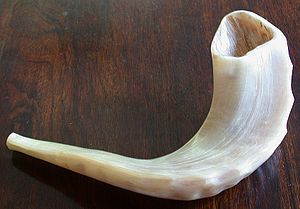When I hear the sound of the shofar [ram’s horn] it seems to echo down the centuries.
The first time I heard it, I was surprised at the rawness of the sound. The shofar is not a fancy musical instrument. It is merely the hollowed-out horn of a ram. There is no mouthpiece, no reed, no metal in it whatsoever.
If you have the opportunity to handle one, you will see that it is just an old piece of horn. And yet this simple object can work wonders on the Jewish heart. It wakes up our souls during the month of Elul. It thrills us on Rosh HaShanah. On Yom Kippur, it shakes us to our core. It awakens ancient memories.
When you hear the shofar, close your eyes. Feel time drop away from you. You are one with all the Jews of history: one with Joshua, one with David, one with the Maccabees. Feel the disturbance in your soul, the urgency of the shofar’s call.
Listen to what the shofar is saying to you.
Click here for the sound of a tekiah gedolah, a long blast on a shofar.


Sounding Shofar During Morning Services During Elul
Arthur L. Finkle
The Code of Jewish Law (Shulhan Arukh, I28:8) instructs that the shofar shall be sounded in the period between rosh hodesh (new month) Elul until after Yom Kippur. The religious rationale was that Moses ascended Mount Sinai to receive the second tablets, dwelt there for 40 days, and descended on the tenth of Tishre, when the atonement was completed. The musi¬cal rationale is that the forty-day period provided the necessary practice to develop the appropriate embouchure.
The religious rationale come from the Midrash (Pirkei d’R’ Eliezer 45; R. Eliezer ben Hyrcanus (80-118 C.E.), a disciple of Rabbi Yochanan ben Zakai and teacher of Rabbi Akiva):
[During the Jews’ first year in the desert,] they received the [Ten] Commandments on the sixth of the month [of Sivan], [and then] Moshe forty days on the mountain studying, [and then] on the seventeenth of [the month of] Tammuz he came down and broke the Tablets. [Forty days later] on Rosh Chodesh Elul, HaKadosh Baruch Hu said to him “Come up to Me on the mountain” (Devarim 10:1), and an [announcement through blowing] shofar was spread throughout the camp, [saying] that “Moshe has gone up on the mountain!” – so that they would not be [led] astray after strange worship [once] again, and [the honor of] HaKadosh Baruch Hu was uplifted through that shofar [blowing], as it says (Tehillim 47:6) “G-d rises up at [the blowing of] the shofar.” Accordingly, the Sages instituted that shofar be blown each and every year on Rosh Chodesh Elul [the authorities’ text – unlike ours which says “Tishrei” (from here on are the words of the Tur and the Rosh – possibly their text to the Midrash itself)] and [throughout] the entire month, in order to urge Israel that they do teshuvah [i.e. “return to Hashem” (repent)], as it says (Amos 3:6), “If a shofar shall be blown in a city [can it be that the inhabitants will not be shaken?],” and in order to confuse the Satan [i.e. angel of Heavenly prosecution].
In rabbinic commentaries, the Rosh (Rabbeinu Asher ben Yechiel, Germany and Spain, 1250 – 1327, ruling at the end of tractate Rosh HaShanah) concludes: “[Indeed,] it is the Ashkenazi minhag (custom) to blow [shofar] throughout the month of Elul, morning and evening, after the prayer [services].”
Commenting on this custom, The Tur (Rabbeinu Yaakov ben Asher, Spain, 1280 – 1345) is in Orach Chayim 581. The Rema, Yosef Karo (Spain, Portugal and Turkey – 1488-1575) brings a variation – blowing only after the morning service (Shacharis). The Mishnah Berurah, an update of religious laws in the Code of Jewish Law, dated approximately 1900) confirms the accepted custom. See http://www.learnhalacha.com/ElulShofar.pdf
The musical rationale is what any instrumentalist would do preparatory to a performance. See Arthur L. Finkle, The Easy Guide to Shofar Sounding, LA: Torah Aura, 2003
Thank you, afinkle221! That’s a lot of terrific information, and wonderful sources!
I got here from twitter well done on a very good social media campaign
Aha! Glad you found me. And glad that the Twitter is working for me! Please do let me know if you have any questions – good questions turn into good articles!